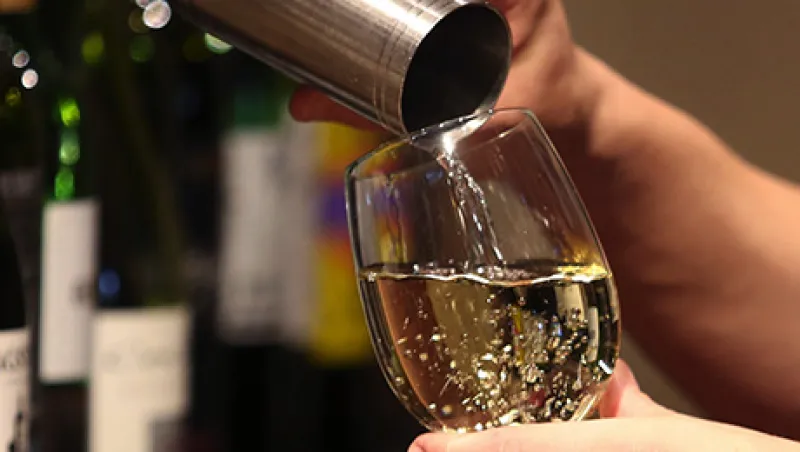Everybody has heard of Black Friday, but what about Blackout Wednesday?
As U.S. university students return home to kick-start the holiday season with friends and family, this ominously named celebration on the eve of Thanksgiving is marked by a surge in binge drinking and an uptick in bar traffic that rivals that of St. Patrick’s Day and New Year’s Eve. Many bars promote the faux holiday with drink specials, and Millennials encourage it on social media: #BlackoutWednesday is trending on Twitter. (Not to be confused with #BlackoutFriday, a viral appeal to boycott stores the day after Thanksgiving to protest the lack of an indictment for the police shooting of a black youth in Ferguson, Missouri.)
The holiday season, from Thanksgiving eve through January 2, is a boon for the alcohol industry. “Total consumer expenditure on beverage alcohol in 2014 is likely to exceed $220 billion,” including more than $40 billion in November and December, says Richard Hurst, principal of New Canaan, Connecticut–based New World Consulting (and father of this reporter). This increase is mainly driven by holiday parties and gift-giving. Holiday sales are often critical for suppliers and wholesalers, Hurst says, as for many December 31 marks the end of their financial year.
Independent licensees generate a significant percentage of their annual sales in this time period too, says John Bodnovich, executive director of American Beverage Licensees (ABL), an association representing on- and off-premise beverage alcohol retailers.
Suppliers and retailers therefore must carefully manage year-end selling. Pricing — whether to cut prices to attract consumers or raise them to take advantage of the natural surge in demand — is a dilemma, as is maximizing current-year sales without compromising next year’s. In 2013 there was little evidence of price discounting during the holiday period, with the possible exception of sparkling wine and champagne.
America’s beer, wine and spirits retail industry will account for more than $245 billion in economic activity this year, including wages and taxes, up from $184 billion two years ago, according to ABL’s “2014 Economic Impact Study of America’s Beer, Wine and Spirits Retailers.” The industry is expected to generate $36.3 billion in local, state and federal excise tax revenues in 2014, with an inevitable bump at year-end from heightened traffic and consumption.
For liquor stores, bars and restaurants, the holiday season means stocking up and staffing up. U.S. licensees provide more than 1.77 million jobs year-round, ABL reports, with a spike in November and December. “We see a lot of seasonal hiring at stores, whether hiring people to do carryouts, stock shelves, increase floor presence or add store security because of increased volume in foot traffic,” says Bodnovich.
“Analysts will be carefully following the performance of the publicly traded companies in the alcohol business, which can act as a barometer for the economy,” says Hurst. The most-watched firms tend to be leading international producers like brewer Anheuser-Busch InBev, spirits maker Diageo and winery operator Constellation Brands.
Ultimately, the success of the holiday season comes down to consumers’ appetite for beer, wine and spirits. “How consumers choose to spend their discretionary income will, of course, be the major determinant of consumption, in and out of the home,” Hurst notes. In general Americans are spending more this year, thanks to rising consumer confidence, steady job growth and a decline in gasoline prices to the lowest levels since December 2010. Recently revised Commerce Department figures suggest the U.S. economy grew by 3.9 percent in the third quarter, its fastest clip in more than a decade. This bodes well for retailers this holiday season.
Consumers are more conscious of what they’re drinking, with a growing preference for winter ales, Christmas ales, spiced beers and ciders this time of year, as well as champagne and limited-release spirits like Pappy Van Winkle, a coveted bourbon, says ABL’s Bodnovich. They increasingly rely on retailers’ expertise in pairing alcoholic beverages with holiday meals. This means retailers must work with brand representatives to ensure that bartenders, wait staff and sales associates are educated on new and seasonal products.
Last-minute shopping has become a growing challenge for inventory management among off-premise retailers such as supermarkets, convenience stores and liquor stores. The buying season for retailers begins in early October, according to Bodnovich, so stores must anticipate sales months in advance. “Liquor store” is one of the top-trending Google Maps searches the day before Thanksgiving. The surge in demand challenges the roughly 70 percent of U.S. beverage alcohol retailers that are small independent operators with limited storage space.
Beer will be the most-consumed alcoholic product during the holiday season, as with the rest of the year, but market share of wine and spirits increases sharply during the holiday period, says Danny Brager, senior vice president of the beverage alcohol practice at Nielsen, the information and measurement company.
A rise in alcohol consumption raises safety concerns, of course, an issue the industry takes seriously. Since 1982, for instance, Anheuser-Busch has spent more than $980 million on promoting alcohol responsibility, such as preventing underage drinking, overconsumption and drunk driving. The Centers for Disease Control and Prevention estimates that a 728 Americans will be injured or killed by alcohol-related incidents each day between Thanksgiving and New Year’s.
The holiday season for alcohol retailers and suppliers inevitably begins with Thanksgiving, as university students count down the hours to one of the busiest bar nights of the year (some even deeming Blackout Wednesday their favorite holiday), and families stock up on beverages to overcome the stresses of family gatherings. “Thanksgiving is not just about the turkey, mashed potatoes and stuffing anymore,” concludes ABL’s Bodnovich. “It’s also about the beer, wine and spirits that you’re serving with them.”






